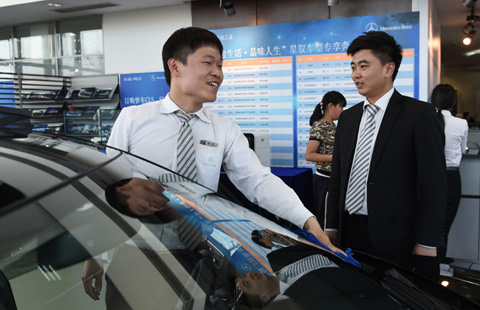Colombia runs into infrastructure bumps on road to prosperity
Updated: 2015-05-22 11:49
By DONG LESHUO(chinadaily.com.cn)
|
||||||||
Colombia runs into infrastructure bumps on road to prosperity
Driving in Bogota can be a roller-coaster-like experience, not only because it is the second-highest capital city in South America at 8,661 feet above sea level.
The barely avoidable potholes on both major and small roadways are likely to reduce one's motoring pleasure when touring the beautiful city, which has been called "The Athens of South America".
The roads are just one aspect of Bogota infrastructure in need of improvement.
Colombia's infrastructure is among the worst in Latin America, according to a World Economic Forum Global Competitiveness Report released in 2014. The report also noted that it is the second most problematic factor for doing business in Colombia.
"It is (one of the) biggest problems facing Colombia right now," Richard Emblin, editor-in-chief of The City Paper told China Daily. "There has been no real plan (for infrastructures) for a post-conflict Colombia.
"This is where things now have to focus as Colombia wants to become global, wants to become a player, as a member of the merging markets like the BRICS," Emblin said.
"Latin America needs China to help close the infrastructure gap," Kevin P. Gallagher, professor of global development policy at Boston University's Pardee School of Global Studies, wrote in the Financial Times on May 19.
Chinese Premier Li Keqiang's current trip to Colombia is expected to enhance bilateral cooperation in infrastructure.
"Colombia has a lot to learn from China about how it builds its infrastructure," Emblin said. "If you look at Shanghai today, like the architecture and the highways, it's pretty impressive."
China has recognized that a modern economy requires reliable roads and railways, electricity and telecommunications. Infrastructure development remains a top priority of the Chinese government.
From the late 1990s to 2005, 100 million Chinese benefited from power and telecommunications upgrades. Between 2001 and 2004, investment in rural roads grew by 51 percent a year, according to Yougang Chen, Stefan Matzinger and Jonathan Woetzel, authors of a 2013 McKinsey report.
China's leadership plans to bring the nation's infrastructure up to a middle-income country level, while using increasingly efficient transport logistics, such as high-speed rail, to connect people across the country.
"It's very difficult to look after 1.3 billion people, but China has maintained social welfare for their people in a way," Emblin said. "What we could learn from China is exactly how to not lose social benefits of the people during development. It's not about just making a lot of money. It's about how do you protect your people and how to lift your people out of poverty."
Contact the writer at leshuodong@chinadailyusa.com

 Journey of a migrant girl from village to ad world
Journey of a migrant girl from village to ad world
 Photographer captures Chinese on the train
Photographer captures Chinese on the train
 Hou Hsiao-Hsien's The Assassin premieres in Cannes
Hou Hsiao-Hsien's The Assassin premieres in Cannes
 Top 10 highest-paid white-collar jobs in China
Top 10 highest-paid white-collar jobs in China
 The dying craft of balance scales
The dying craft of balance scales
 Culture Insider: Six things you may not know about Grain Buds
Culture Insider: Six things you may not know about Grain Buds
 Premier Li rides on new China-made train in Rio de Janeiro
Premier Li rides on new China-made train in Rio de Janeiro
 NYC's new One World Observatory offers sweeping views of Manhattan
NYC's new One World Observatory offers sweeping views of Manhattan
Most Viewed
Editor's Picks

|

|

|

|

|

|
Today's Top News
Li: 'Great potential' for Sino-Colombian ties
Beijing responds to surveillance by US plane
Beijing sets out its rights after reports of incursion
China may have edge in race to build California's bullet train
US Senate votes to move forward fast-track trade legislation
Colombia runs into infrastructure bumps on road to prosperity
Premier Li arrives in Bogota to start official visit to Colombia
China is a global leader in renewable energy: Panel
US Weekly

|

|






